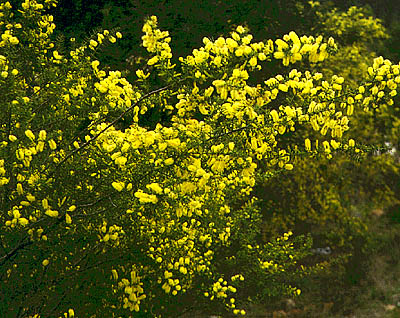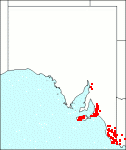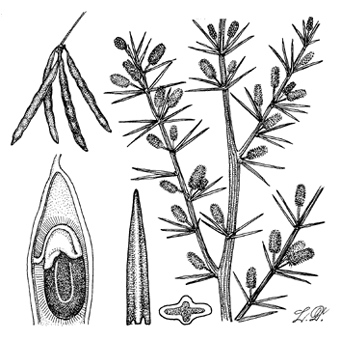Family: Fabaceae
Acacia verticillata

Citation:
C. L. Willdenow, Sp. Pl. 4:1049 (1806). Mimosa verticillata L'Her., Sert. Angl. 30 (1789).
Derivation: verticillatus (Latin)--whorled, refers to the whorled phyllodes. Synonymy: A. verticillata L'Her. var. ovoidea (Benth.) Benth., Fl. Aust. 2:335 (1864); Racosperma verticillatum (L'Her.)Martius, Hort. Reg. Monac. Semin. (1835). Common name: Prickly Moses
Description:
Rather polymorphic prickly, dull green, spreading-erect, spindly or bushy shrubs, 1-4 m high, sometimes procumbent with a few trailing branches; branchlets light green, prominently angular, striate, often pubescent. Phyllodes acicular, or flattened and then narrow-lanceolate, 0.8-1.5 cm long, 1-2 mm broad, mostly whorled but some on same branches alternate or fascicled, sessile, rigid, divaricate or reflexed, 1 prominent central vein tapering into a pungent point. Inflorescences simple, 1-3 per axil; spikes dense, 8-15 mm long; peduncles and receptacles glabrous or slightly hairy, 1-2 cm long; flowers 4-merous. Legumes linear, 3-8 cm long, 3-4 mm broad, flat, straight or curved, dark brown, margins pale, slightly thickened, not constricted between seeds. Seeds longitudinal; funicle short, folded below a fleshy aril.
|
|
Distribution:
|
Flinders Ranges (a minor occurrence near Mount Remarkable) mainly Southern Lofty, Kangaroo Island and South-Eastern regions associated with heath understorey in open forest or woodland in valleys and on hillsides; often found in damp situations. Soils: on a variety of soils from hard acidic or sandy acidic, neutral or alkaline yellow duplex. Rainfall 600-1200 mm. Also N.S.W., Vic. and Tas.
|
Conservation status:
Lang & Kraehenbuehl (1987) consider this species to be Rare in the Flinders Ranges region otherwise of no special conservation significance. Flowering time: August — November. |

SA Distribution Map based
on current data relating to
specimens held in the
State Herbarium of South Australia
|
Biology:
No text
Taxonomic notes:
The waxing and waning of Acacia verticillata following bushfire was reported by Ashton & Chappell (1989). Initially the Acacia was dense to impenetrable 5 years after fire. It was considered mature at 10 years and then was 4-5 m tall. After 20 years it had begun to senesce. In some areas it was replaced by other shrubs and only limited regeneration of the Acacia occurred in mid-slope areas of the experimental site. The once dense Acacia became a patchy uneven-aged community with an age span of more than 15 years.Gardner (1971) describes the occurrence and use of a cultivar Rewa in New Zealand where it is grown as an ornamental. A. verticillata is now naturalised in New Zealand, Webb et al. (1988).
Cultivation:
Grows well in heavy or sandy soils but does best in damp situations. The procumbent forms are suitable for rockery planting. Fast growth rate.
Author:
Not yet available
References:
Source:

|

